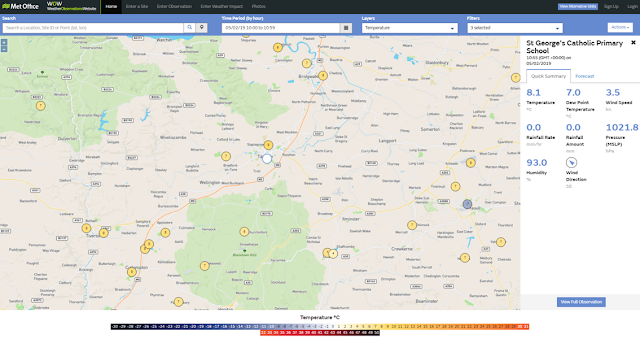Back in July, the UK surpassed its maximum temperature record
during an exceptional period of heat. Persistent low pressure sat across
eastern Europe and Russia, alongside another area of low pressure that had
stagnated just to the west of Europe (occasionally bringing unsettled and
cloudy weather to parts of Spain and the UK), trapping an area of high pressure
in between.
 |
| MSLP analysis chart - valid 06 UTC 25th July 2019. |
This allowed anticyclonic conditions to set in across much of
central and western Europe, bringing clear skies, plenty of sunshine by day and
light winds too. This weather combination ensured that by the 22nd
July (Wednesday) temperatures were beginning to rise into the high 30's, with
the peak heat concentrated across parts of France, Belgium and the border
region between Germany and the Netherlands. Indeed, by the end of Wednesday (24th),
the Belgium national met service (RMI - Royal Meteorological Institute) confirmed
that the temperature in Kleine-Brogel had peaked at 39.9°C during the day. Meanwhile
KNMI released a statement, stating that the official maximum temperature record
for the Netherlands had been surpassed in several locations on the 24th,
with the highest temperature (39.3°C) recorded in Eindhoven.
Where is the hot weather coming from? Find out below 👇 pic.twitter.com/XtHf2xroEP— Met Office (@metoffice) July 22, 2019
As for the UK, a breezy and rather cloudy start to Monday 22nd
July gave way to increasing sunshine and lighter winds by Tuesday as an
approaching cold front swung up towards the northwest of the UK. This allowed a
southeasterly feed of air to develop through the day across much of the
country. Even at this point, numerous
AWS (Automatic Weather Stations) on WOW recorded in excess of 35°C, although an
official UK maximum temperature of 33.7°C was recorded at Northolt.
Intense overnight thundery downpours spread their way across
England and Wales, clearing to brighter skies for a time on the 24th,
although a band of cloud arrived from the west during the afternoon capping
temperatures somewhat in across central and western parts. In the east,
however, back garden AWS sites suggested 30°C+ temperatures across parts of
East Anglia, Cambridgeshire and London. In fact, the official maximum was
recorded at Writtle (34.3°C).
It's exceptionally hot for some this afternoon, and scattered thunderstorms will develop pic.twitter.com/FmdwPHsUSQ— Met Office (@metoffice) July 25, 2019
 |
| Visible satellite image taken on 25th July |
By Thursday (25th), low pressure had retreated
westwards a little and was now just to the west of Northern Ireland, allowing a
more widespread stream of hot air from the continent to feed across the UK. Official
Met Office observation sites across parts of Wales and Scotland recorded
temperatures in excess of 30°C, whilst numerous official sites across England
saw temperatures rise into the mid 30's.
With a maximum UK temperature record of 38.5°C previously
recorded in Kent (2003), unsurprisingly, there was a lot of interest from a
range of press outlets regarding the maximum temperature on the 25th
July.
Multiple WOW locations recorded temperatures in the high 30's, with a few
recording in excess of 40°C by 3pm. Clearly many journalists were watching WOW
with some interest at the time as some journalists even quoted temperature
readings from individual weather stations. Likewise, Met Office Meteorologists
were keeping an eye on WOW alongside official Met Office network temperature
data.
 |
| UK WOW observations recorded 15:00-15:59 UTC 25th July 2019. |
Whilst WOW data was not treated as official UK observational
data, it did provide a steer as to where the highest temperatures could be
found in real time (in three areas; Cambridgeshire, London and Kent). Temperature
readings from WOW also filled in data sparse gaps in official Met Office networks
(often in towns and cities), providing an indication of just how widespread the
heat was.
 |
| WOW observations near Cambridge recorded 15:00-15:59 UTC 25th July 2019. |
However, as the Met Office has a number of official networks,
that range from official automatic observation sites (that report in as near to
real time as possible) to Voluntary Climate Network sites, it wasn't possible
for the Met Office to release the highest temperature from the 25th
July on the same day. It was not until the next morning that the UK learnt just how high the
temperature had risen on the 25th. As it turns out the highest
temperature was actually recorded at Cambridge Botanic Gardens - a Voluntary
Climate Network site, manually read once every 24
hours by volunteers. Consequently, this particular site did not report in on
the hour or the day but delivered a dramatic pause overnight until the value
was released into WOW at 0900 UTC on the 26th July.
A provisional maximum temperature
of 38.7°C was released by the Met Office thereafter. Meanwhile, in the
background, a rigorous series of processes were undertaken by Met Office staff
in order to verify this figure. These processes included:
- A site inspection and sensor inspection
- Review of the temperature trace
- Discussion with the onsite climate observer to ensure the correct processes were followed on the day (i.e. the Stevenson Screen was not opened other than at the prescribed time)
It is worth
noting that there were some serious impacts of the exceptional temperatures seen
in late July. For example, in the UK, the rail network was severely affected
across south-east England with train cancellations and main lines closed out of
London due to concerns with rail buckling. Meanwhile, damage occurred to
overhead electric wires as they sagged in the heat, and trackside vegetation
caught fire in several locations. In addition, the exceptionally hot weather
made conditions difficult, particularly for the frail and elderly. Further
afield, as temperatures rose into the 40's across parts of France, Belgium,
Germany, Luxembourg and the Netherlands, a number of fatalities were reported.













